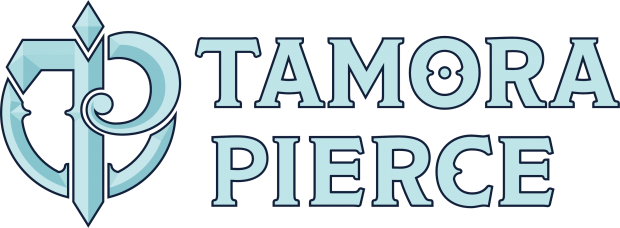Margaret A. Edwards Award Speech
Here is the original text of Tammy’s Margaret A. Edwards Award speech, as requested by some fans.
What a long, strange trip this has been—and yet I can’t complain. If you feel bitterly used and wish to exact vengeance at the end of my talk, I wish you luck, because it’s my father’s fault that I’m here, and he is swapping stories with the fellows in Valhalla. He was glad to hear that I fought my mother to watch the British TV series “Robin Hood” every weekday morning before I ran to school. You see, my father had three daughters, which means that I was the oldest son. I was never good at outdoor things, but when it came to books and television, my father shaped me. We shared the adventures of Thor Heyerdahl and Sir Edmund Hillary, Howard Pyle’s renditions (for boys) of the adventures of Robin Hood and of King Arthur, the historical novels of F. Van Wyck Mason and Kenneth Roberts, and the books of Edgar Rice Burroughs, Mark Twain, and Edgar Allen Poe. He approved heartily when I read the family Golden Library editions of The Iliad and The Odyssey. We watched “Davy Crockett” together, the World War II drama “Combat!”, and the original “Star Trek” series. My mother, who was a brilliant, troubled woman, oversaw my education in liberal politics and issues, and in religious and social history. She was the reason that my middle school principal introduced me to a visitor as “our little women’s libber.” It was the 1960s. Things were changing. I breathed in feminism long before my friends at school.
Not that I had many friends. Up until third grade things were all right. I lived in a small coal town where everyone dressed the same. Then we moved to the San Francisco Bay Area. I was obviously poor: one kid said I looked like a “refugee from a rag bag.” I used “big words.” I read too much. I knew no popular songs or dances or TV shows (we had no TV by then). I was beat up and bullied. A girl who had been my best friend the day before joined others at my bus stop to throw dirt clods at me.
As for writing, apparently the signs were there: I won an essay contest in the local paper when I was in fourth grade; I got Bs and As on English and social studies papers; I wrote a 20-page short story for speech class. One day, when I was in sixth grade, my father caught me telling stories to myself. He suggested that I write a book. I figured that if he thought it was a good idea, I would try it, and I asked what I should write about. He thought for a moment, knowing what interested me, and then he suggested that I write about travels in a time machine. I got to work.
My parents’ marriage came apart. Soon my dad was gone, but I had the bug. I wrote what I wanted to read: adventures in which girls were the active heroes. I had trouble finding books where girls, or women, did things. In kids’ books girls were only part of the adventure in historical novels. Mara, Daughter of the Nile juggled two masters and faced down the Pharaoh Hatshepsut. (A female pharaoh! It took me forever to find anything else about her!) Caddie Woodlawn rode through the dark to warn her Indian friends the whites were coming to kill them. Then, one Friday in seventh grade, my homeroom teacher handed me The Fellowship of the Ring. Fantasy was an arena where women could be warriors, fighting in battle. Except, well.
Eowyn surrenders her sword at the end of the trilogy. C.L. Moore’s Jirel of Joiry asks her men-at-arms why they cower in the corner like so many women. Robert Howard’s pirate queen Belit dances naked for Conan and dies at the end of the story. For the rest, in fantasy women were oversexed trophies or sword fodder, there to die. Science fiction, which I found later, was much the same with a few notable, largely sexless, exceptions, like Robert Heinlein’s Peewee and Isaac Asimov’s Susan Calvin. Until I found Lessa of Pern and Frank Herbert’s women, science fiction women were playmates, background, or collateral damage. I continued to write what I wanted to read: female warriors—girl warriors—who made sense. Who would not surrender what they had labored to become, even if they fell in love. Who were not dislikeable. Who fought enemies who looked suspiciously like the people who made my life a misery at school. What can I say? I’m not good at making characters up.
I had some other issues. No one ever went to the bathroom in fantasy. People with a sense of humor? Virtually none. As a teenager I knew I would not make it to adulthood without humor. As for realism? When I found Robert Howard’s Red Sonja, she had been adapted for comics to wear a chain mail bikini. I had fallen asleep once in the shade, wearing a wet bathing suit. This woman was traveling and sleeping rough in metal swimwear, in conditions I knew caused pain. And in the Sierras in September, in the Rockies in June, at Girl Scout camp in a redwood forest, I had slept out of doors. I used an outhouse at zero temperatures. There were bugs, sticks, and rocks in my bedrolls, bee stings in sensitive areas, and cold, cold showers. None of these things appeared in the fantasy I read. I wanted my fantasy real so I could live in it.
Then, in tenth grade, I struck a speed bump. I had written a story about “what I knew,” at my English teacher’s urging, about a girl at a birthday party. It seemed okay enough to submit it to Seventeen Magazine. I got a kind letter from the fiction editor in reply. That night my mother asked why I’d heard from Seventeen, and I told her, thinking she would be proud that I’d had the courage to submit a story.
We had fought about my writing before. It was a thing of my father’s, and she hated it. But this was the fight to end all fights as she worked one theme: who was I to think I was good enough to submit to a magazine.
I did not write any original fiction from my tenth grade year until the summer before my junior year in college. I was majoring in psychology when the dam broke in the form of a short story of five agonizing pages.
A year later I sold my first story to a romance magazine. The sale gave me the courage to take a course in writing short fiction. My teacher, David Bradley, Jr., made it plain that he thought I was talented. He urged me to tackle a novel, preferably about my dramatic childhood. I couldn’t do it. Hanging there, five or six pages in, stuck and terrified that I was facing more years of writers’ block, I made a crash decision to try for literature later and write the kind of thing that had me filling reams of paper before I reached tenth grade: sword and sorcery fantasy with girl heroes. That first novel was nothing to show anyone. It did help me break through the wall between short story and novel, which was all that I needed it to do.
In November of that same year I had an idea, one that became a 732-page manuscript I titled The Song of the Lioness. We write what we want to read: here was everything I wanted. Alanna has a temper. She is as outspoken as I was afraid to be for years, growing up in my mother’s house. She is too stubborn to know when to quit. She finds strength in her friendships, just as I have always done. Most important to me, after my years spent reading “high fantasy,” she lives a real life. In the wilderness, she gets cold; she bundles up. As Alanna grows older her body changes, which felt like ruin to a motherless girl who is masquerading as a boy. I used something for Alanna that happened to me, with one difference: I was overjoyed when I saw my chest bobble in the mirror, because my mother then had to keep her promise and get me a training bra. Alanna was furious at her body’s betrayal of her real sex.
She does recover eventually to live a sexual life. Unlike other young noblewomen of her time and like most young women I knew in the seventies, Alanna had that choice. She had cut herself off from the strictures of medieval marriage, just as Keladry would do. She made decisions about her sexuality, just as I did. Alanna, having an open sex life, gets birth control. I never thought any of these choices were controversial, revolutionary, or unusual. They were part of my reality; therefore, they became part of the Tortall universe and the Circle universe.
During the years that I sent the first single manuscript to adult publishers, I had different jobs. One was that of housemother in a group home for teenaged girls. When the director learned that I had a book the girls wanted to read, he asked about the material. I told him there was sex, violence, and drug and alcohol use. He said that the girls couldn’t read it, since these things had gotten them into the home in the first place. We worked out a deal. After the girls came home from school and at night, before they went to bed, they demanded the story. I sat with the manuscript in my lap and retold it, edited—though not as much as the director thought it was edited. The girls loved it. When I was finished with Alanna’s story, I wrote space adventures for them until I moved to New York. Small wonder that, when I showed my manuscript to literary agent Claire Smith a year later, and she told me to break it up into four books for teenagers, I knew I could do it.
In the rewrite, as at the group home, I didn’t change as much of the material as people sometimes think I should have done. It never occurred to me—or to Claire, or to my editor, the great Jean Karl, or if it did, they never mentioned it. I drew a curtain over the explicit sex, but I had done that for my girls. I deleted the drug use in magic; it wasn’t necessary and I didn’t want kids to think I advocated it. I tussled with Jean over the use of brandy as a restorative in LIONESS RAMPANT. We came to a compromise that I feel worked even better, Liam Ironarm’s herbal messes. And throughout my rewrite, the one that became a quartet, I worked to make the books even more real.
Both Alanna and, later, Kel, have to work for their combat skills. Having listened to men’s scorn on the subject of women in combat for years, I wrote both girls’ training very carefully. On the field, they work to keep up, honing their speed and endurance. Alanna deliberately trains with weighted weapons. Kel is tricked at first into using weighted weapons, but once she knows what she has, she keeps them to build up her arms. I knew to include these things because by the time I wrote the first draft of the Lioness books, I had discovered martial arts movies. There I picked apart fight scenes, trying to weigh what was real and what was rigged. I read magazines and wrote martial arts movie reviews. I studied tae kwon do until I tore a ligament and observed different kinds of martial arts classes and demonstrations.
Once LIONESS RAMPANT was finished, I was very happy to leave Alanna behind. I had been working on her story for fifteen years. I was ready for something different. I created the Daine books, the Immortals quartet, centered on a girl hero who was more about who I was at 30 (Alanna was me at 12, or the me I would have been if I hadn’t loathed P.E.) and began the Circle of Magic universe with Scholastic. And yet I was restless. I felt that by making Alanna both a mage and a knight I had done her a disservice. Certainly I had short-changed her mage side. I was covering mages with the Immortals books and the Circle books, but I wondered I should try one more knight. I asked a classroom full of fans what they thought. Their vote was overwhelmingly positive and vocal. Then I mentioned it to my new editor at Random House, Mallory Loehr, and she said, “We’ll take it!”
I knew my knight could not be like Alanna. Usually I base characters on actors, performers—or people I know. In this case, I had a fan-friend, a girl I had corresponded with for years. People rode her constantly about her weight. When we met I saw a tall, splendid mare of a girl who was into active sports like rock climbing and kayaking. My Keladry, based on my friend, would be a tall, big girl for all the big girls out there. She would serve under a different king and queen than Alanna, train under a hostile master, and live in a world transformed by the arrival of magical creatures and beings. She would also have no magic. Her life was already complicated enough; she could represent the majority of people in this world, who have no magic, but live with it all around them.
Alanna is peppery and mouthy—Keladry is calm. Alanna is best with a sword. That was tricky if Kel was to be different. Then I thought of my fascination with samurai Japan, and Kel’s family connection to, and her time in, the samurai-like Yamani Islands unfolded. She does share one thing in common with Alanna—with all of my female heroes. She is as stubborn as the day is long. Honestly, I don’t know where they get it.
Kel must also face unique challenges as the first girl who openly goes for her knighthood in two centuries. Since college I have followed the stories of the first women to enter our military schools and the ranks of the military. I know women in the service and women who have left it. Kel cannot complain, or her enemies will only make her life harder. Superior officers and the boys and men who train with her will be unsympathetic or even downright hostile. They will be even more determined to drive her out.
Kel’s story is more political than Alanna’s because I have grown more political over the years. Tortall is in an uproar over the many changes that have come with the new regime. To get things done, the monarchs have had to compromise with the powerful conservative faction, and Wyldon, the training master, is popular with the conservatives. (It doesn’t hurt that Wyldon saved the lives of the royal children in the recent war.) He brokers a deal in which he can decide if Kel is fit to continue as a page after a year’s training. He also gets the king’s promise that Alanna, who would have been Kel’s natural ally, be forbidden to come near her, on the grounds that she might assist Kel magically. Everyone assumes that Wyldon will kick Kel out at the end of her first year, because he is open about not wanting The Girl. He never foregoes a chance to tell her all the things that make women wrong for life as a warrior, as men who claimed to think highly of me have told me all my life. As my father told me when I lived with him and my stepmother, the year I worked in the group home. Yet Kel proves Wyldon wrong, not with arguments, but with what she does. Like any woman in the modern military and in outfits like the police and the fire department, she works harder than the boys to keep up. In Wyldon, with his scars and his skills, she sees the knight she wants to be. She doesn’t pay attention to his inability to bend. And slowly, against his own will, he sees in her a fighter as indomitable as he is himself. Almost in spite of himself, he begins to help her to overcome the fear of heights that has been with her since she was a child. He lets her stay, and she continues to show him what she is made of, just as he understands that here is someone who is good at the things he can teach. He also stands that in teaching the other boys his own stony, merciless code, he has done them a grave disservice.
To survive her time as a page, squire, and knight, Kel has friends. Neal is one of my most popular characters, a sharp-tongued former medical student who cannot keep silent. He tells us what we need to know about things Kel isn’t aware of or will not examine. An idealist who turned to cynicism at the university, he has rediscovered his idealism at the hands of a girl five years his junior—a girl, moreover, whose response to romantic excess is to urge him to eat his vegetables. As a contrast to Neal Kel has Owen, the cheerful, outgoing younger brother who will blurt out your secrets and immediately leap into any fight in which you are taking part. Slowly, other boys from among the pages come to stand at her side showing the bullies among the pages that they will no longer reign unopposed. Kel’s friends also learn that if they listen to her in a crisis, she will keep them alive.
Unlike Alanna, Kel has female friends. The closest is her maid. At first Lalasa is terrified of her young mistress, until she must explain Kel’s first physical changes to her. That early bond is strengthened when Kel, finding Lalasa has been abused, teaches her how to defend herself. Lalasa is also gobsmacked to find that Kel does not blame her for the abuse, but her abuser, a paradigm shift in Lalasa’s world. No longer mistress and maid when they are alone together, they know they can trust one another. For birth control, Kel gets the talk from her mother. Claire Smith had urged me to write a good mother someday, and after knowing a couple, including Claire, I was able to do it. Ilane was also a warrior in the Yamani Islands, another woman whose history gives Kel strength.
My family had always had cats, birds, and dogs when I was young. Working on the Daine books, I got to know the available New York City wildlife I had by feeding animals in the parks and streets. Alanna had her horse Moonlight and her purple-eyed black cat Faithful, a gift from the Goddess, based on my college cat, Fido. In Kel’s case, the pages are now forbidden pets, but there is forbidden, and there is forbidden. Due to Daine’s power spreading wherever she is, animals are aware of humans and their motives. When tender-hearted Kel feeds the courtyard sparrows, they decide to move in. Based on some of the birds I knew in Riverside Park, they become Kel’s scouts and alarm system. Jump is the dog I always wanted, a bull terrier who won’t obey orders he doesn’t agree with. He is very good at taming crusty training masters. Then there is the gelding Peachblossom, a monster of a horse who hates everyone, until Daine brokers a deal for him with Kel. Now Peachblossom is Kel’s horse, as long as she does not use the spur. Kel’s human friends know to keep out of range of his teeth. In SQUIRE Kel also illustrates my encounters with caring for injured wild animals and feral cats when she looks after a baby griffin, based on my best friend’s dove. Like me, Kel feels the sadness and relief of releasing a rescue to the place where it belongs.
In the third book Kel’s destiny takes shape. It’s spelled out by her knight-master, Lord Raoul, who commands the King’s Own. He explains the types of knight, including heroes like Alanna, and commanders—those who lead troops on the field and care for them before and after battle. Raoul thinks Kel has what it takes to be a great commander. He teaches her about the paperwork that is a commander’s lot, about how not to treat a king, and in the end, how to command a small unit in combat.
She is ready for her great trial in LADY KNIGHT, when she is placed in charge of a refugee camp. I had always known her camp would be attacked while she was away, the children taken to a mage who uses their souls to create monstrous killing devices. I did not know that, the day after I finished writing Kel’s trip to her district commander’s fort, it would be an earthshaking day for New York City and for my country. It would be September 11, 2001. When I found the energy to write again, Kel was returning to a camp in ruins and a search for the dead. I had to both tap and vent my emotions during those horrible weeks, as I struggled to write Kel’s great tragedy and her reaction, and to cope with our country’s pain and my own. I have only been to the southern tip of Manhattan twice since then, when I used to go once or twice a month. When Kel faces the child-stealer, the child-killer, based on a historical murderer of children, it was a relief for us both, and it wasn’t. That scar in the earth would never fade for either of us, back at her former camp, and where the World Trade Center used to be.
I continue to talk to military women and read their stories during Kel’s quartet and after, incorporating what I learn. I don’t want young women to think entering the military will be easy. And I have received letters, most notably one from a woman who commanded a ship for the navy, and another from a woman who served as a patrolwoman, a detective, and on the bomb squad, who tell me that I have gotten it right. Other writers have told me that Kel has helped them to deal with their parents by showing them how to control their temper. Recently I got a letter from a fourth-grader, who said that thinking of what Kel did to overcome her fear of heights helps her to face her own fear of the dark. I have heard too many times to count that LGBTQ fans took, from a brief exchange between Kel, Neal, and their bullies, that I thought it was okay to be LGBTQ. They tell me this, leaning close, in tears, leaving me in tears. I promised that I would do better than one elliptical exchange. And I have.
I have cooler fans than anybody. I thank them all the time for honoring me with their passion. As well as my fans, I also thank the committee who gave me this wonderful award, my editors and publishers, my present wonderful agent, Craig Tenney, my writing buddy Bruce Coville, and my long-suffering Spouse-Creature and IT guy, Tim Liebe. It takes a lot of people to get me where I have been, to reinforce my faltering will, and to send me on to the books I will continue to write for them.
Am I finished with girl knights, or girl warriors? Not at all. Not only have I already created girl spies and girl cops in my medieval universes, in addition to the mages, but we will see Kel—and other girl knights—again.
Before I learned to read, I was looking at a book where I saw an etching of a girl in chain mail armor. That image, that idea, of the girl, the woman, prepared for battle stayed in my mind’s eye for years before I wrote about her. She haunts me. She haunted humanity even before a girl named Joan put on armor, unsheathed a sword, and went to raise the siege at Orléans. The armor may have changed, but the girl is as determined as ever. She just needs the right fuel, the right encouragement for her dreams and battles.






Achievements, Awards, Margaret A. Edwards Award, Publicity